You’ll find Flagstaff’s high-desert charm in weathered pines, volcanic scars, and neon Route 66 signs, where morning hikes turn into stargazing nights at Lowell Observatory and easy drives lead to the Grand Canyon’s rim. Wander cliff dwellings, sip local brews, and climb peaks that reward wide-open views; there’s a mix of history, outdoor thrills, and quiet moments that’ll make you want to keep exploring what’s just around the next bend.
Explore the Grand Canyon (Day Trip From Flagstaff)
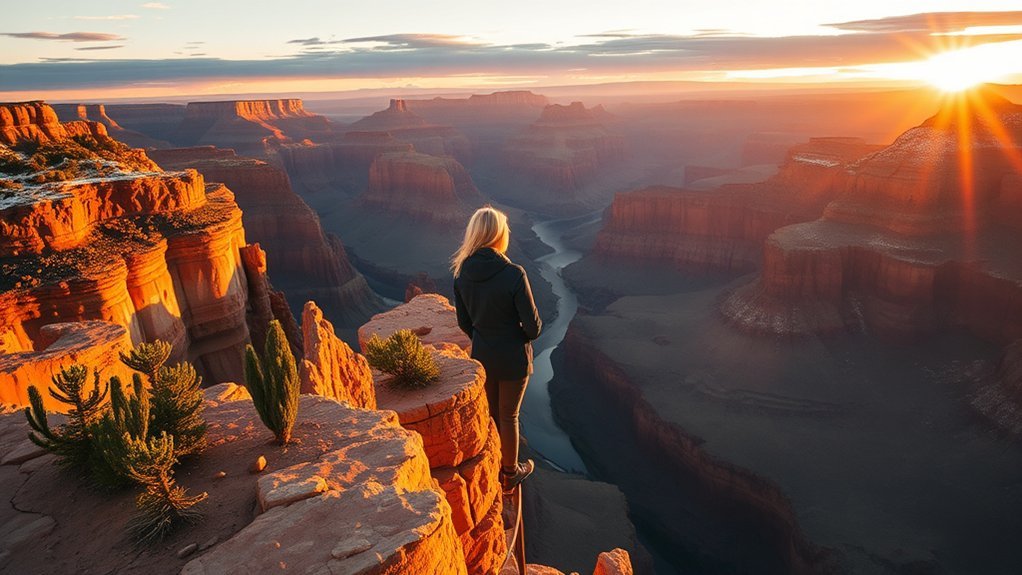
If you’ve only got a day, make it count: drive from Flagstaff to the South Rim and stand where the canyon drops away in a riot of layered reds and ochres, the Colorado River a thin ribbon far below; the scale hits you first — a dizzy, understated roar of space that makes your problems look small and your camera suddenly inadequate. You’ll walk the rim trails, toes near stone ledges, breathing air that tastes like pine and sun-warmed rock. Guides point out geology and ghost stories; you’ll pause to watch shadow and light stitch the walls as afternoon moves. Bring water, a hat, and patience — vistas demand unhurried attention. If you time it right, sunset paints the cliffs copper and violet, and the hush feels deliberate, like the canyon’s way of asking you to listen. Driving back, Flagstaff’s stars will feel closer, a quiet counterpoint to the day’s vastness.
Wander Through Walnut Canyon National Monument
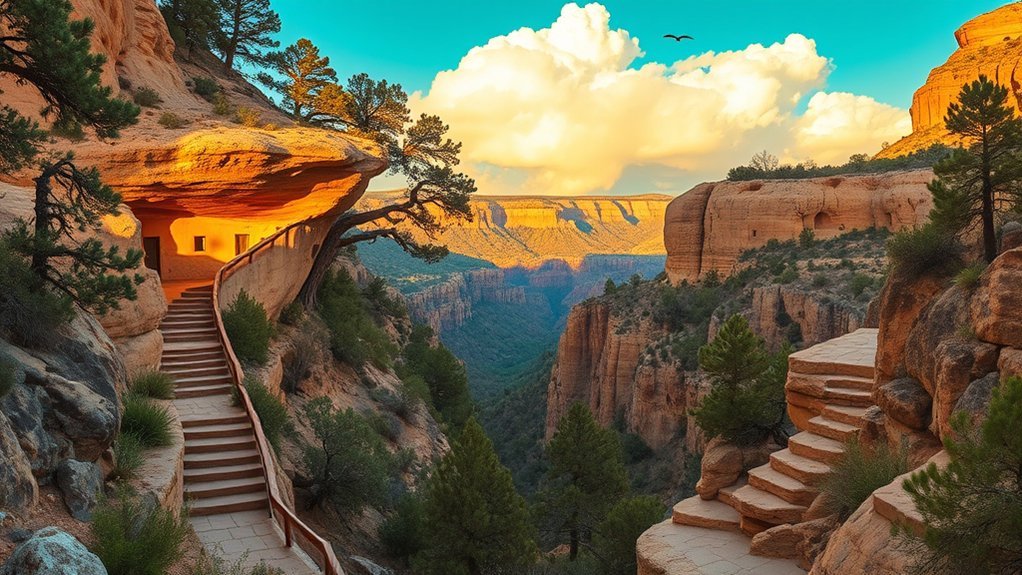
Step onto the Rim Trail and you’ll feel the canyon open up beneath your feet as switchbacks lead to well-marked trailheads and access points. You can explore ancient cliff dwellings perched in alcoves, imagining the lives once lived there while scrub oak and pinyon scent the air and ravens wheel above. Keep your eyes peeled for rock squirrels, lizards, and sweeping vistas that frame Flagstaff’s high desert skyline.
Trailheads and Access
Park in the small lot, lace up your boots, and you’ll find the Walnut Canyon trailhead just a short walk from the visitor center; the Rim Trail and Island Trail both start here, giving you options to descend into the canyon or enjoy panoramic views above. You follow a worn path where pinyon and juniper scent the air, sunlight dappling sandstone. The Rim Trail unfurls along the canyon edge, offering wind-whipped vistas and quiet pullouts to catch your breath. Choose the Island Trail and stairs lead you down into cooler shadows, where the trail narrows and rock formations rise like frozen waves. Wayfinding signs are clear, distances modest, and restroom facilities sit near the lot—practical details that keep your focus on the landscape.
Ancient Cliff Dwellings
Stone rooms cling to the canyon walls like a timeworn honeycomb, and when you walk the Island Trail you literally pass through centuries of daily life—hearths, niches, and low doorways carved by the Sinagua people who raised families here between 1100 and 1250 CE. You feel the cool shade shift as you descend wooden steps, hearing your boots against ancient stone while imagining voices and footsteps long silent. Light slices into alcoves, illuminating pottery fragments and mortar joints that hold stories. Interpretive signs point connections without stealing mystery; ranger talks lend context. Move slowly—this place rewards quiet attention and respectful curiosity.
- Start at the visitor center for maps and exhibits
- Wear sturdy shoes for uneven trails
- Bring water; shade is limited on the switchbacks
- Join a ranger-led walk if available
- Respect barriers and fragile masonry
Flora, Fauna, Views
From those quiet rooms etched into the canyon walls you can follow a path of living history down into Walnut Canyon, where junipers and pinyons crowd the rim and mule deer pick their way among the rocks. You descend narrow trails. Needles and resin scent the air while scrub oak brushes your sleeve. Look up: cliff faces host hardy agave and tiny cactus clinging to seams, bursts of wildflower color after rains. Ravens wheel above, their calls echoing off stone; lizards sun on warm boulders. Stops at overlooks reward you with layered vistas—red sandstone, green forest, distant San Francisco Peaks. You move slowly, senses sharpened, feeling how this place balances fragile life and stark geology in a quiet, vivid tableau.
Visit Lowell Observatory for Stargazing
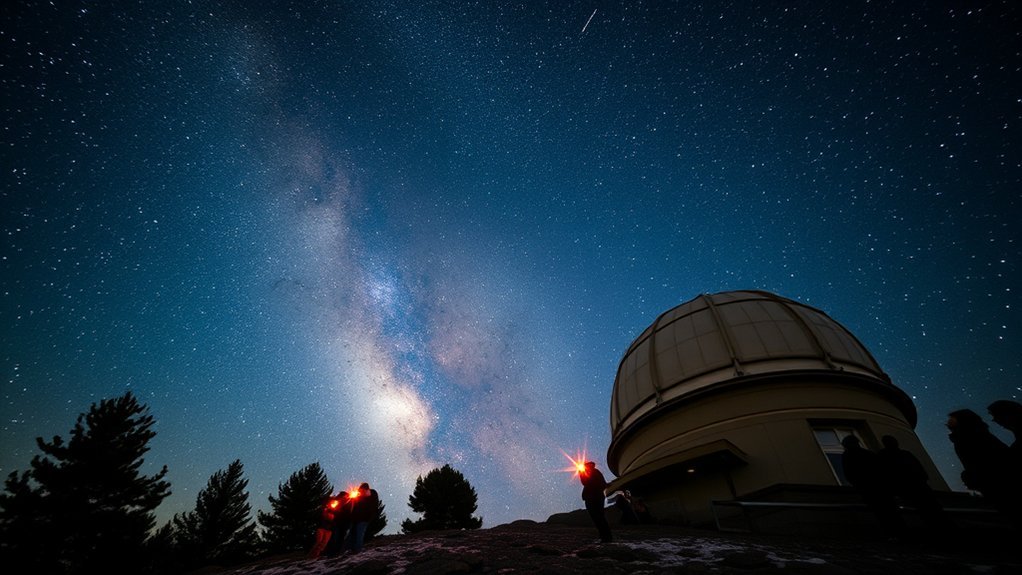
When night falls you’ll stand under a sky so dark the Milky Way feels within reach. Join a Lowell Observatory night sky program to watch guides point out constellations and share stories while telescopes bring planets and nebulae into crisp focus. Don’t miss the historic telescope tours—walking past instruments that once changed astronomy makes the cosmos feel suddenly personal.
Night Sky Programs
If you step onto the Lowell Observatory grounds as dusk falls, the sky seems to deepen into a velvet canvas and the telescopes come alive, ready to guide you across planets, nebulae, and distant suns. You’ll join guided night sky programs that pair expert narration with live views, letting you trace Saturn’s rings, Jupiter’s storms, and the silver smear of the Milky Way. The guides point out constellations, weave myths, and explain what the light tells us about time and distance. You’ll feel small and electrified beneath that sweep of stars, camera forgotten as you watch photons from eons land in real time.
- Arrive early to learn basic sky lore
- Dress warm; temperatures drop quickly
- Use red lights to preserve night vision
- Ask questions; guides welcome curiosity
- Bring a notebook for surprising observations
Historic Telescope Tours
Step up to a living piece of scientific history at Lowell Observatory, where you’ll walk past storied domes and peer through telescopes that once helped map the solar system. You’ll feel the cool stone underfoot and hear guides recount discoveries as you approach instruments that recorded Pluto’s faint motion. Standing at the eyepiece, you’ll sense the same focused hush that scientists felt decades ago. Guides weave technical detail with human stories, so the sky feels immediate and intimate. After a guided look, you’ll linger on terraces, watching constellations rotate into view as city lights fade. This tour isn’t just observation — it’s a tactile link to past breakthroughs and a chance to see how you still connect to the cosmos.
| Telescope | Highlight |
|---|---|
| Clark Refractor | Historic views |
| Perkins | Research legacy |
Hike Humphreys Peak (Arizona’s Highest Point)
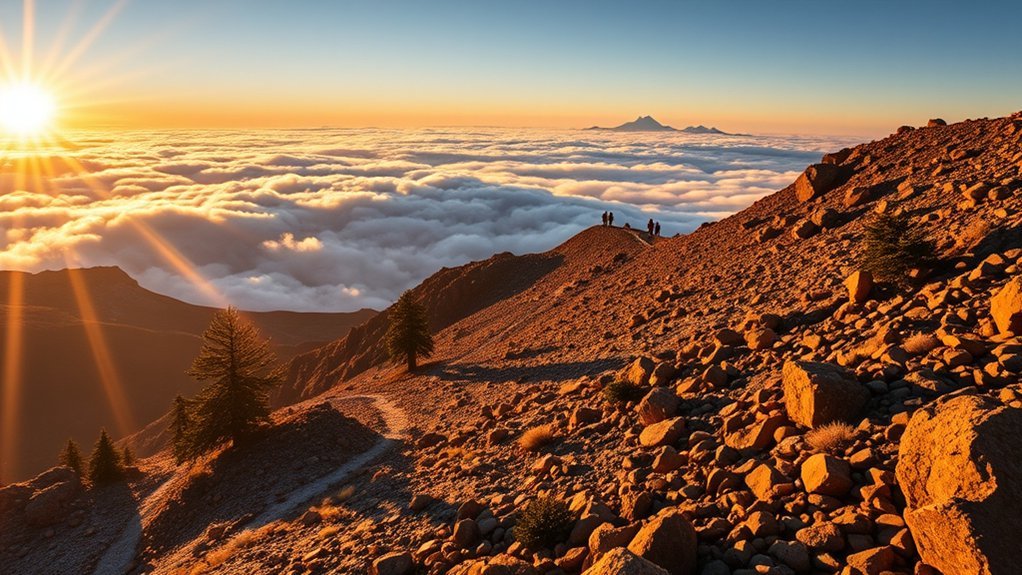
Although the climb can be challenging, you’ll feel every mile worth it as you gain altitude through fragrant pine forests, alpine meadows dotted with wildflowers, and finally the windswept tundra near Humphreys Peak’s summit — Arizona’s highest point. You’ll follow a well-marked trail that tests your lungs and rewards you with sweeping vistas of the San Francisco Peaks and distant deserts. The air thins, the sky deepens, and each step sharpens your awareness; pause to listen for wind and birdcalls, to taste cold, clear air. At the summit, you’ll stand where the state’s horizon unfolds in all directions, a moment both humbling and exhilarating. Plan for sudden weather shifts, bring layers, and start early to avoid afternoon storms. Your descent will feel easier, the landscape rearranged by altitude and effort.
- Check trail conditions and permits before you go
- Pack water, snacks, and layers for temperature swings
- Wear sturdy boots and sun protection
- Start pre-dawn for cooler temperatures and views
- Leave no trace; carry out all trash
Stroll Historic Downtown and Route 66
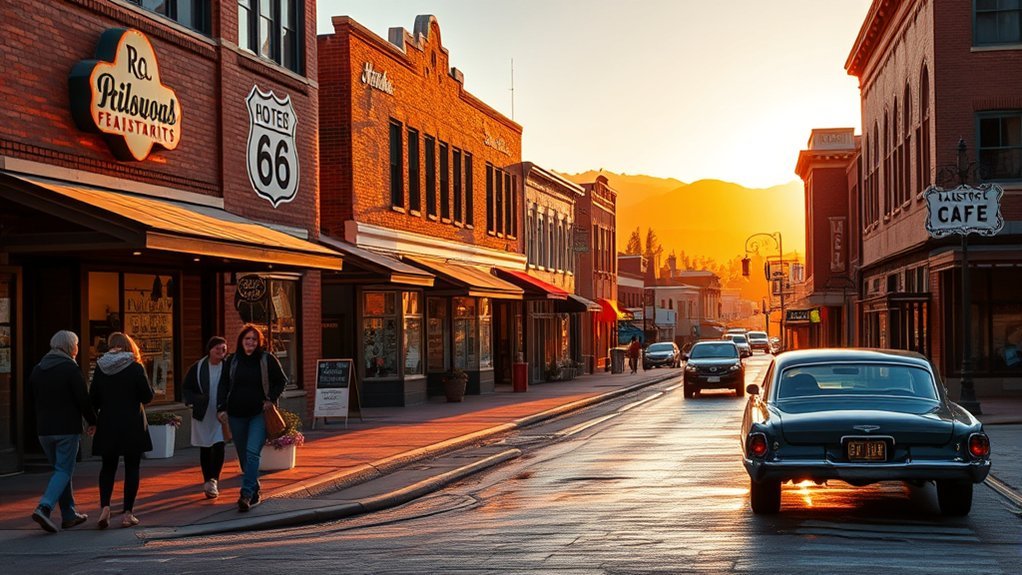
When you wander down Historic Downtown Flagstaff and along a stretch of old Route 66, the town unfolds like a living postcard—brick facades, neon signs, and cozy cafés invite you to slow your pace and notice the small details: carved wooden awnings, weathered map plaques, and locals trading stories on shaded benches. You’ll drift between indie shops and antique stores, fingers tracing cool glass and brass, finding vinyl records, desert art, and hand-thrown pottery that feel like souvenirs of a place rather than a moment. Stop for coffee at a sunlit patio, watch cyclists glide by, and let the scent of pine and roasting beans mingle. At dusk, neon blooms against a twilight sky and the streets take on a cinematic hush; you’ll hear footsteps on brick and the soft clink of cutlery from a corner bistro. Walking here isn’t just seeing Route 66—you’ll feel its layered history under your soles.
Drive the Scenic Oak Creek Canyon
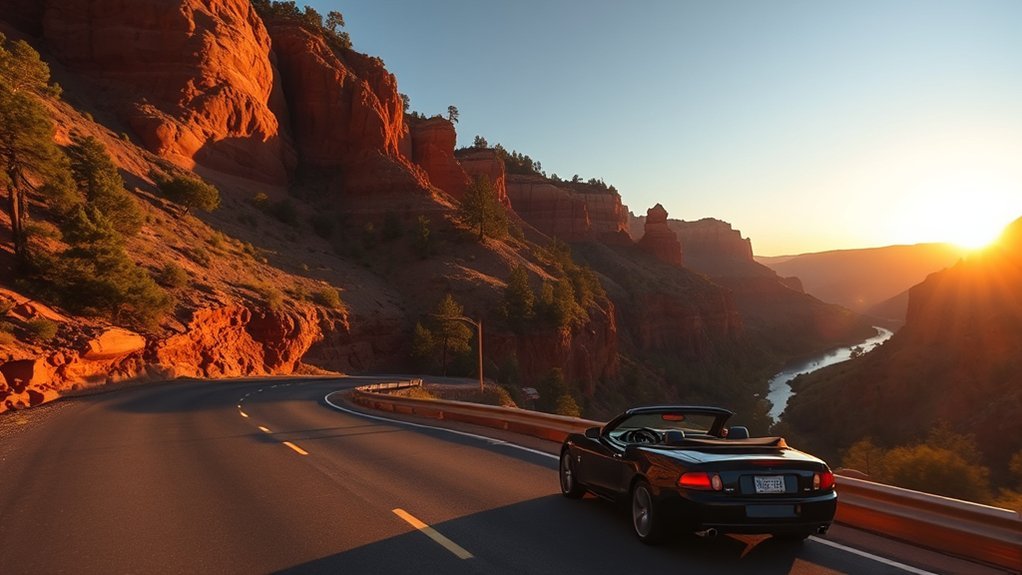
A ribbon of road carves through cedar and red-rock walls as you drive Oak Creek Canyon, each bend revealing a new frame of glittering water, sun-splashed cliffs, and trembling aspens; roll down the window, catch the pine-scented air, and let the canyon’s changing light set the pace. You’ll feel the shift from ponderosa shade to open redstone, hear water threading over stones, and spot secluded pools where sunlight writes gold on green water. Pull over at turnout overlooks to let the view sink in, wander short trails that drop to the creek, and time your drive for late afternoon when shadows and color deepen. Keep your camera ready but don’t miss simply watching: light moves fast here, and the canyon rewards patience. Respect narrow shoulders and seasonal closures, and consider a slow, unhurried loop so each vista has its moment.
A winding road through cedar and red-rock, each bend unveiling glittering water, sunlit cliffs, and trembling aspens—pause, breathe, watch light unfold.
- Park at designated pullouts for safety and views
- Bring layers—temperature changes quickly in canyon shade
- Hike brief side trails to reach creekside pockets
- Avoid peak holiday traffic; go weekday mornings if possible
- Carry water, snacks, and a trash bag to leave no trace
Tour the Museum of Northern Arizona
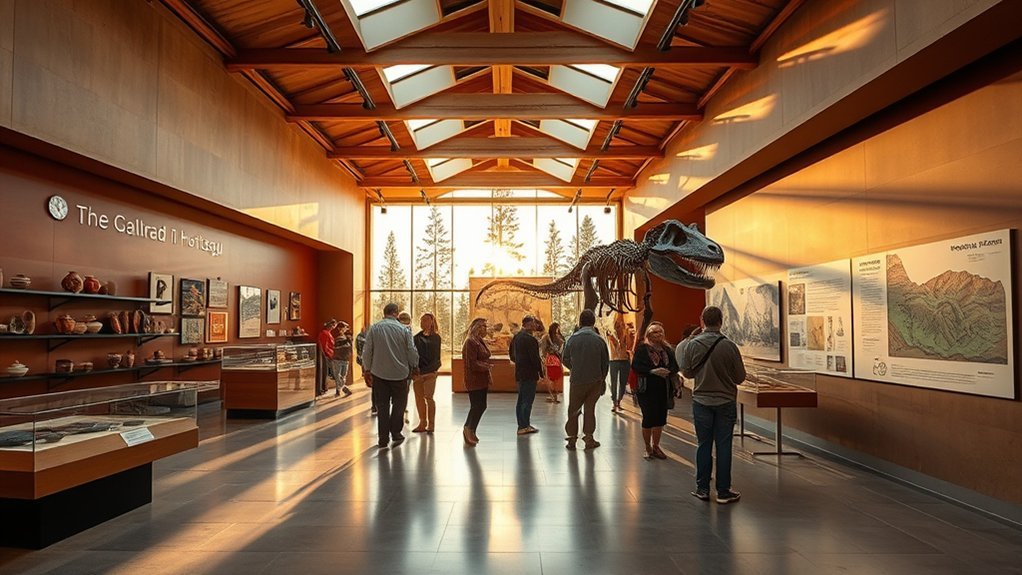
Step into the Museum of Northern Arizona and feel the weight of centuries through its Native American collections, where pottery, textiles, and jewelry speak to living traditions. You’ll trace the region’s story in vivid geological exhibits that lay out ancient landscapes and volcanic drama. Check the calendar—special programs and events bring artists, storytellers, and scientists to life for hands-on, memorable experiences.
Native American Collections
Sunlight filters through tall pines as you approach the Museum of Northern Arizona, where corridors unfurl like chapters of the Colorado Plateau’s living history. You step into galleries filled with woven patterns, pottery silhouettes, and beadwork that pulse with ancestral technique. Voices of place hang in object labels; tactile displays invite a closer look, and curators’ stories connect clans to landscapes. You’ll feel respect, continuity, and artistry shaped over centuries.
- Pause at the Hopi katsina figures and notice fine carved details.
- Trace Navajo weaving designs and learn about dye traditions.
- Read oral histories that put objects in family context.
- Attend a rotating exhibition highlighting contemporary Indigenous artists.
- Visit the research library to deepen your understanding.
Geological Exhibits
While you follow the museum’s winding halls, rock cases and dioramas unfold the Colorado Plateau’s deep-time drama—each slab, crystal, and fossil arranged to show how volcanoes, rivers, and ice sculpted the land you’re standing on. You trace layers of sediment, feel the grit of ancient riverbeds described nearby, and watch a volcanic sequence explained with clear graphics. Specimens gleam under soft light; explanatory labels anchor the wonder in science. The room hums with quiet discovery as you connect stone to story and realize the scale of time beneath your feet.
| Specimen | Significance |
|---|---|
| Petrified wood | Ancient forests, climate clues |
| Volcanic glass | Eruptive history |
| Fossilized shell | Shallow seas once here |
| Crystal formation | Mineral growth processes |
Special Programs & Events
If you time your visit right, the Museum of Northern Arizona turns from a steady gallery into a living classroom where artists, scientists, and Indigenous storytellers share their work and wisdom. You’ll step into hands-on workshops, watch potters shape clay with ancestral techniques, hear researchers unpack desert mysteries, and sit rapt as elders braid history into story. Light through the tall windows warms display cases, and the air hums with conversation and ceremony. Special exhibitions rotate, performances surprise, and community nights invite questions. You leave with more than photos — you take context, connection, and a deeper sense of place.
- Check the museum calendar before you go
- Join a guided tour or curator talk
- Attend a live demonstration or workshop
- Respect ceremonial spaces and protocols
- Buy local art from the museum store
Ski or Snowboard at Arizona Snowbowl
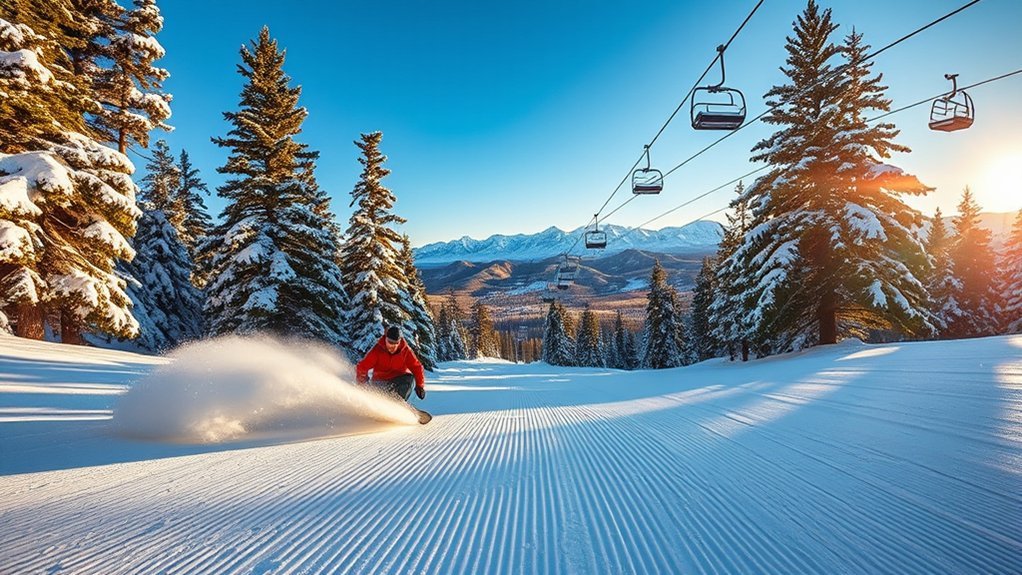
Strap on your skis or board and head up to Arizona Snowbowl, where you’ll carve through high-elevation powder beneath towering ponderosas and sweeping views of the San Francisco Peaks. You’ll feel the crisp mountain air as you climb the lift, watching as pines recede and ridgelines open into wide bowls. Groomed runs reward confident arcs, while tree-lined chutes and steeper faces invite you to test your edge. Midday sun glints on crystalline cornices; late-afternoon light gilds the peaks in gold and rose. Friendly patrollers and efficient lodges make logistics simple, so you can focus on line choice and flow. Whether you’re refining powder technique or ripping blues, every run offers perspective-changing vistas and a satisfying burn in your legs. After a long day, you’ll relish a hot drink and the ache of earned altitude, already planning your next ascent into Snowbowl’s high-country quiet.
Walk the Arboretum at Flagstaff
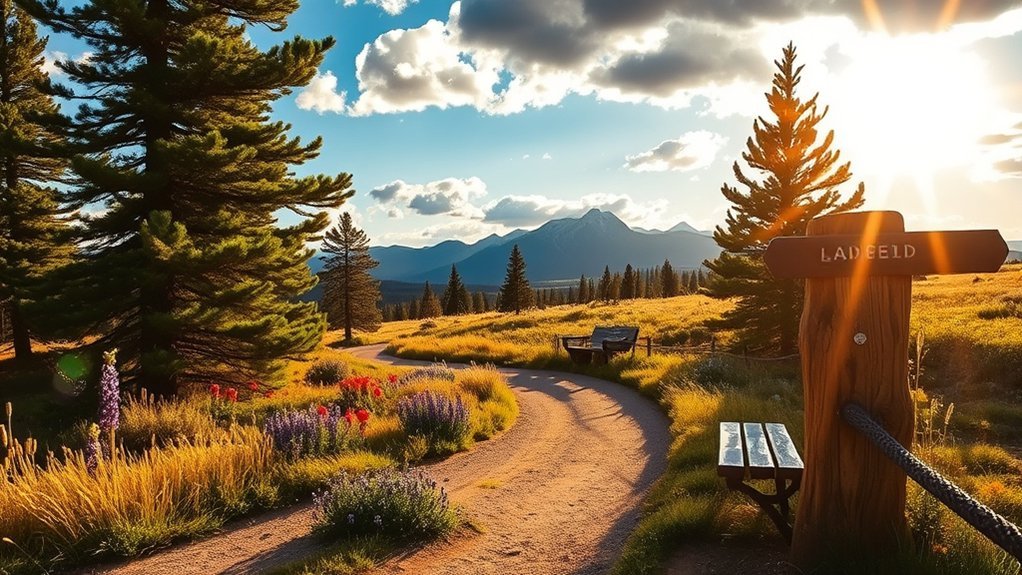
After a day on the slopes, slow your pace and head to the Arboretum at Flagstaff to soak in a different kind of high-country calm. You’ll wander trails lined with aspen and ponderosa pine, breathe cold, resin-scented air, and notice how light filters through needles to paint the ground in gold. The gardens teach you regional ecology without feeling like a lecture; interpretive signs and labeled specimens let you identify native wildflowers and shrubs by touch and sight. In winter, quiet snow muffles footsteps; in summer, hummingbirds dart among blooms. Take time to sit on a bench, listen for wind in branches, and watch the sky shift from blue to bruised evening hues—small, clear moments that reset you.
- Wear layered clothing and sturdy shoes for uneven paths.
- Grab a trail map at the entrance to plan a loop.
- Bring water and a camera for close-up plant portraits.
- Visit the native plant nursery for seeds or advice.
- Respect seasonal closures and stay on marked trails.
Discover Sunset Crater Volcano National Monument
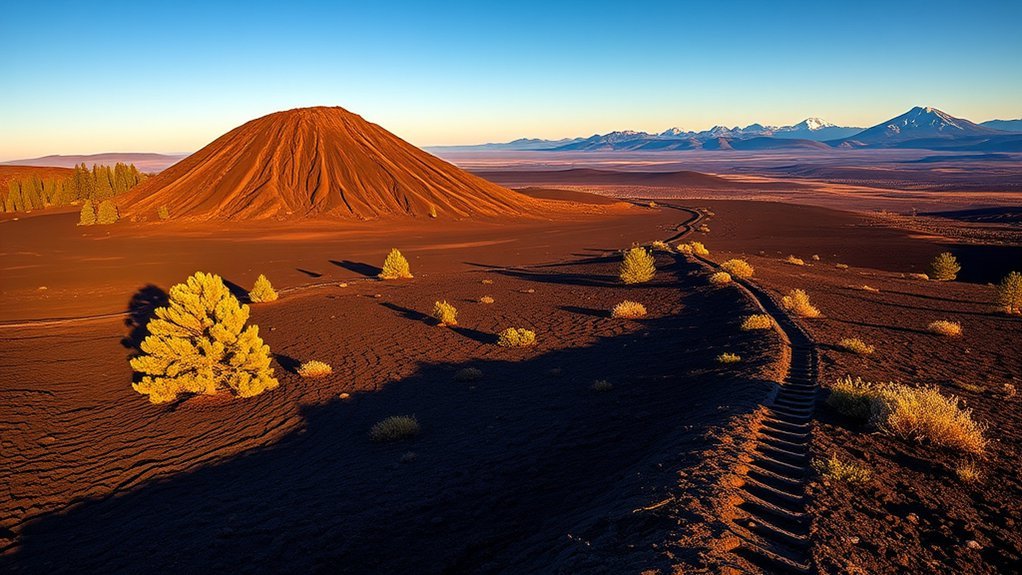
Step out onto the black cinder slopes of Sunset Crater and feel the landscape change beneath your feet—lava fields, jagged spires, and stark, wind-swept pumice stretching from the crater like a dark sea. You’ll follow short trails that thread between hardened flows and fragile vegetation, each step revealing fresh angles of the cone’s rust-red rim against an impossibly blue sky. The air tastes clean and slightly mineral; distant ponderosas stand like sentinels on the horizon. Interpretive signs point out geology and the 11th-century eruptions that reshaped the valley, but you’ll learn fastest by watching textures—glass-like basalt, airy scoria, and lichen reclaiming rock. Pause at a lookout as light slides across furrowed lava, then descend into hollows where silence gathers. Bring good shoes, water, and a camera; the colors and contours change dramatically with the sun. Leave quietly—this is a volcanic landscape still settling into its long, slow recovery.
Bike the Flagstaff Urban Trails System (FUTS)
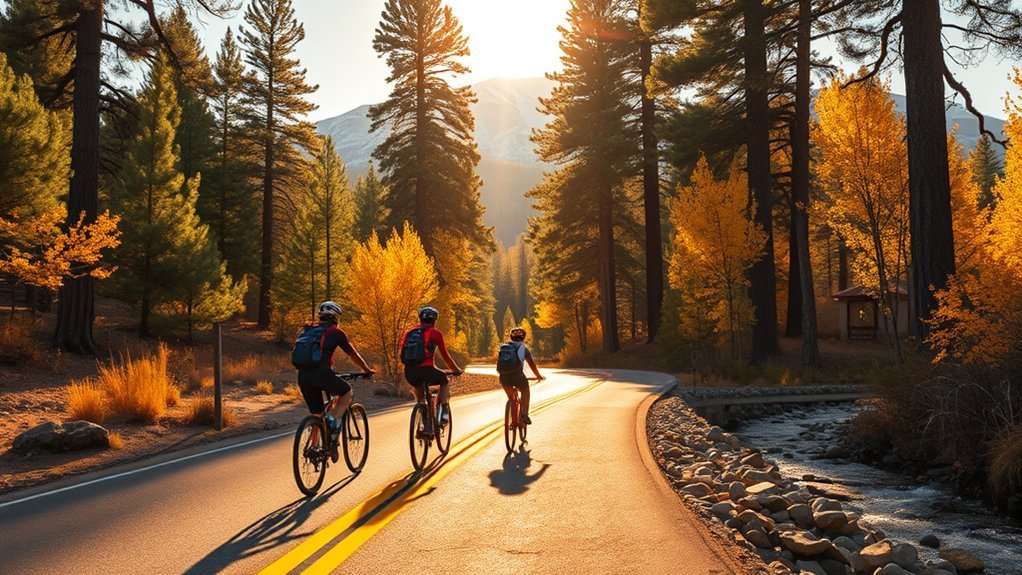
From the volcanic silence of cinder slopes you can roll back into town and clip onto the Flagstaff Urban Trails System (FUTS), a stitched network of paved and packed-earth paths that lets you explore neighborhoods, creeks, and ponderosa pockets by bike. You’ll feel the shift from high-desert hush to a living ribbon of trail: sunlight through tall pines, juniper perfume, and the faint clatter of town life. The routes are gentle but varied, perfect for a relaxed cruiser or a gravel bike seeking singletrack-adjacent dirt. Stop at creek crossings to listen, detour through historic districts to watch porches and murals glide by, and time a ride for golden-hour light that makes aspens shimmer. Maps and signage are clear, and benches invite slow moments. You’ll leave with a sense of place — Flagstaff’s neighborhoods and nature connected under your wheels, a small-city expedition that feels larger than its miles.
From cinder slopes into town, FUTS threads pines, creeks, and porches—slow rides that make Flagstaff feel wide.
- Check trail maps and plan loop distances
- Carry water and layered clothing
- Use a hybrid or gravel bike for comfort
- Respect pedestrians and local wildlife
- Time rides for morning or late afternoon light
Explore Wupatki National Monument
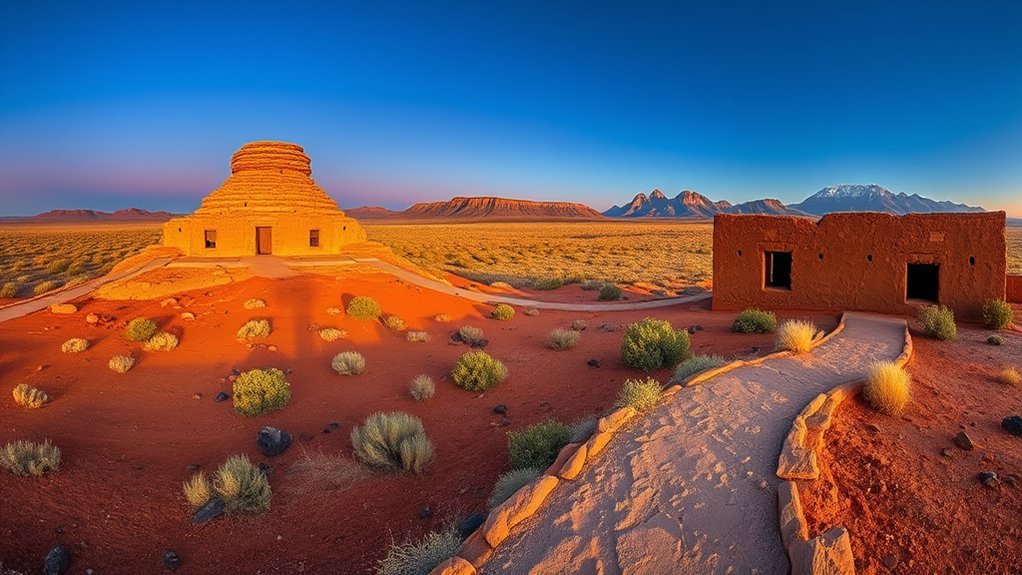
You’ll feel the weight of history as you walk among the Ancient Puebloan ruins, their stone walls rising from the red earth like echoes of past lives. Volcanic cinder cones and lava flows frame the horizon, creating a stark, otherworldly landscape that’s a photographer’s dream. Take your time on the trails—each turn offers a new view that connects the ruins to the rugged geology around them.
Ancient Puebloan Ruins
Wander among towering sandstone pueblos and you’ll feel the weight of centuries settle in the dry air—Wupatki National Monument lays out a quietly powerful landscape of red walls, crumbling plazas, and kivas where Ancient Puebloan people lived, traded, and observed the stars. You trace worn steps, press your palm to sun-warmed stone, and imagine market days when traders moved shells and pottery across the basin. Wind carries the hush of those who shaped rooms and courtyards; light slices narrow doorways, revealing layered lives. You won’t just see ruins—you’ll sense a community’s ingenuity in water-harvesting terraces, masonry, and sky-oriented architecture that still speaks.
- Walk guided trails at sunrise for cooler, golden light
- Read interpretive panels to place sites in time
- Respect fragile structures; stay on paths
- Bring water and sun protection; shade is sparse
- Photograph details: masonry, kivas, and expansive horizons
Scenic Volcanic Landscapes
After tracing sun-warmed stones and imagining ancient markets, look up to the blackened ridges and you’ll see how fire shaped this place: lava flows and cinder cones ring the monuments, carving a dramatic backdrop of jagged basalt and glassy obsidian. You’ll walk between ancient pueblos and stretches of hardened lava, feeling texture underfoot that’s millions of years old. Wind carries the scent of dry pine and dust, and light slants across rippled pahoehoe and rough ʻaʻā fields, throwing stark shadows. Stop at a rim to watch the wide desert meet volcanic silhouettes; colors shift from umber to rust to purple as the sun moves. The landscape feels alive, raw and strangely intimate—an elemental story you can touch.
Sample Local Brews on the Flagstaff Ale Trail
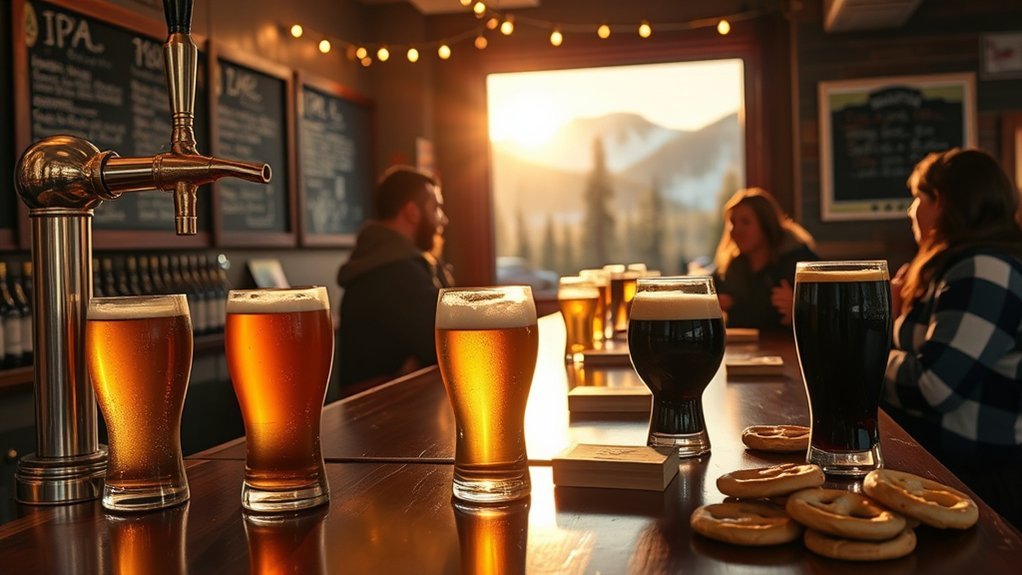
Hop from one cozy taproom to the next along the Flagstaff Ale Trail and taste how northern Arizona’s high-desert climate and pine-scented air shape each brew. You’ll notice bright, crisp lagers that echo the altitude, caramel malts warmed by wood smoke, and hop-forward pales that cut through the mountain air. Each pour feels like a local story: farm-to-glass ingredients, brewer banter, and rustic tasting rooms with sunlit patios. Move slowly—sip, smell, and let the resinous pine and desert florals reveal themselves. Ask bartenders for seasonal releases and small-batch pours; they’ll point you to barrel-aged stouts or citrusy saisons you wouldn’t spot on a menu. Keep your phone ready for photos of amber hues against the pines, and plan rides between stops so you can relax fully.
- Try a flight to compare textures and hop profiles
- Visit a brewpub for a fresh, beer-forward meal
- Ask for brewer recommendations and tasting notes
- Time stops for happy hour specials
- Support local bottles to take home
Take a Sunset or Night Sky Photography Tour
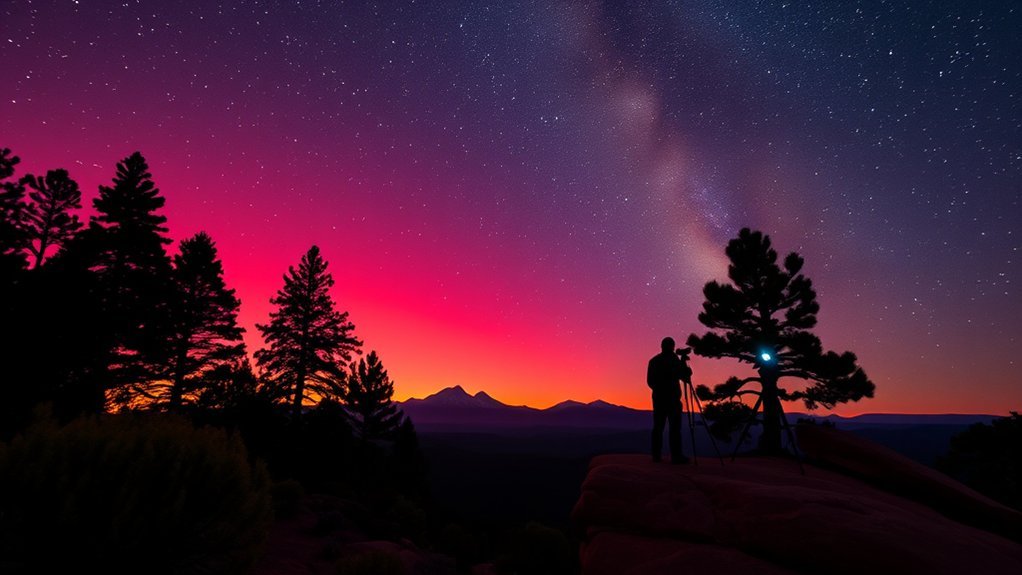
Head to a guided sunset or night sky photography tour and watch the light change from golden to ink-black as stars ignite overhead. You’ll learn the best windows for shooting—golden hour, blue hour, and the darkest hours after moonset—and how to read clear-sky forecasts. Instructors will show you essential gear and techniques, from sturdy tripods and wide-aperture lenses to long exposures, focus stacking, and low-noise settings so your images sing.
Best Times to Shoot
When the sun dips behind the ponderosas and the sky melts from gold to deep indigo, that’s when Flagstaff truly sings for photographers; plan your shoot for the hour before and after sunset to catch the richest colors and the first hints of starlight. You’ll feel the air cool, watch silhouettes sharpen, and see constellations unfurl as city lights dim. Aim for clear nights near new moon for the Milky Way, and check weather and light-pollution maps so you don’t waste a luminous sky. Arrive early to scout compositions and stay late to let the night deepen. Timing turns good pictures into unforgettable ones — patience, presence, and timing are your companions.
- Shoot during golden hour and the following blue hour
- Target new-moon windows for Milky Way vistas
- Scout locations before sunset for framing
- Monitor forecasts and light pollution levels
- Allow extra time for unexpected atmospheric colors
Gear and Techniques
Although the sky will change faster than you expect, bring gear that lets you adapt: a sturdy tripod, wide-aperture lens (14–35mm for landscapes, 24–70mm for more framing options), a remote shutter or cable release, and extra batteries and memory cards so you won’t lose shots to cold or long exposures. You’ll hike into cooling pines, set a tripod as light fades, and watch colors bleed into stars. A guided sunset or night tour shows you composition hints, helps you dial long exposures, and points out constellations you’d miss alone. Your camera becomes an instrument of memory: slow shutter trails, pin-sharp silhouettes, Milky Way arcs. Practice manual focus, bracket exposures, and embrace foreground elements to make Flagstaff’s sky sing.
| Gear | Purpose |
|---|---|
| Tripod | Stability |
| Wide lens | Expansive sky |
| Remote | Blur-free |
| Extras | Power & storage |
Visit the Riordan Mansion State Historic Park
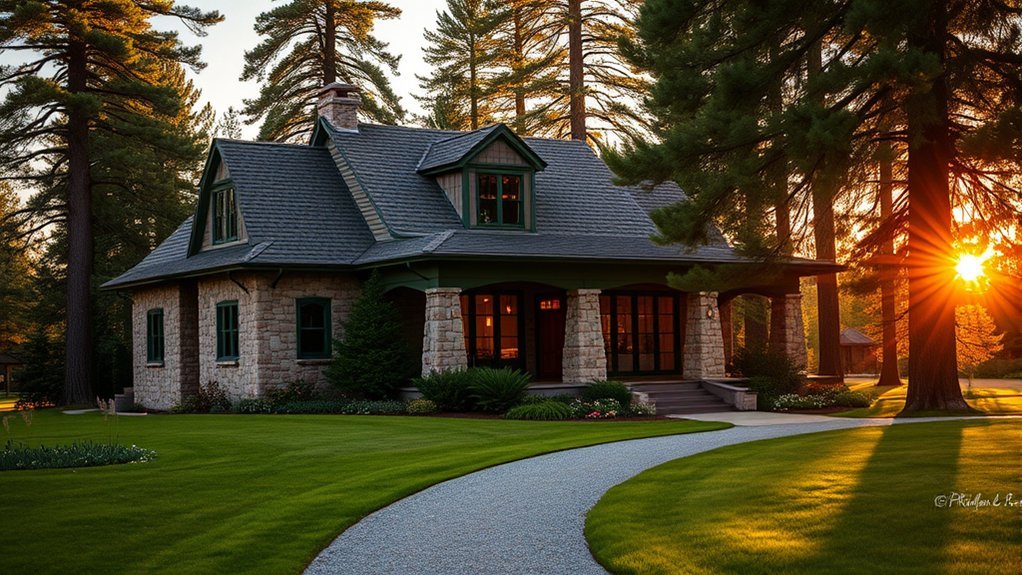
Step into the cool, timbered rooms of Riordan Mansion State Historic Park and you’ll feel Flagstaff’s turn-of-the-century spirit come alive. You wander polished wood halls, light pooling through leaded glass, and sense the Riordan family’s lodge-like life: cozy nooks, hand-hewn beams, and stone fireplaces that anchor each room. A guided tour lets you hear stories about their lumber and railroad ties to Arizona’s early growth; you touch craftsmanship and imagine winter evenings warmed by conversation and cedar smoke. Outside, the landscaped terraces and ponderosa pines frame the house against a high-desert sky, inviting a slow moment to breathe history.
- Arrive early to join a guided tour and catch detailed anecdotes.
- Bring a camera for architectural details and forested views.
- Wear comfortable shoes for gravel paths and uneven floors.
- Check seasonal hours and special exhibits before you go.
- Combine your visit with nearby downtown stops for a full day.
Go Sledding or Snowshoeing in Winter
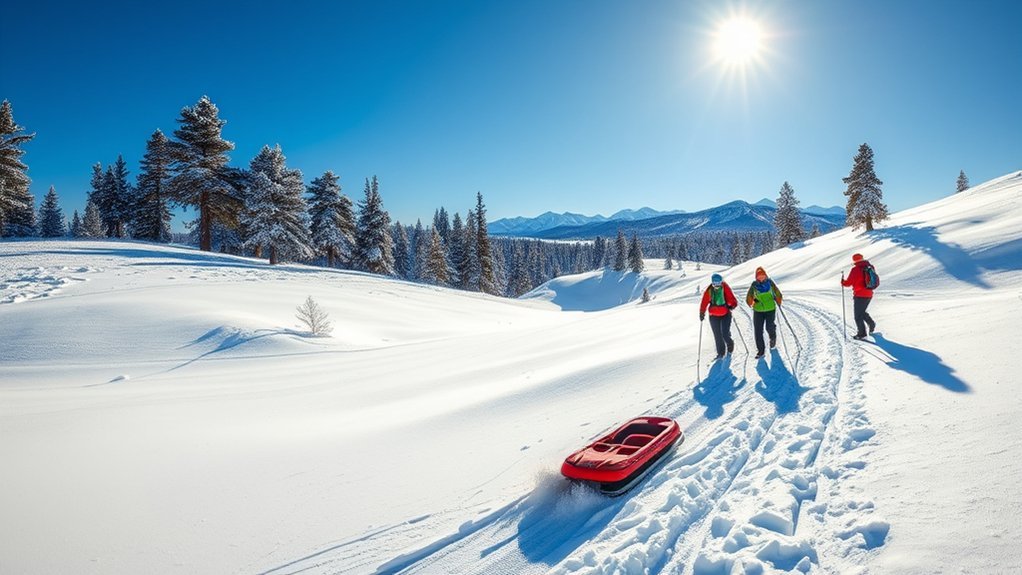
When the asphalt gives way to glittering drifts, you’ll find Flagstaff’s best snowshoe trails winding through silent pines and across broad, sunlit meadows. Pick a top sledding hill—kids laugh as sleds whoosh down groomed runs while adults scout gentler slopes for a calmer glide. If you need gear, local shops and rental huts keep a selection of snowshoes, sleds, and warm extras so you can step straight into the snow.
Best Snowshoe Trails
If you want to trade desert heat for crisp, pine-scented air, Flagstaff’s winter trails deliver—wide meadows and silent forests perfect for snowshoeing and playful sled runs tucked just off the main paths. You’ll follow elk tracks, feel snow hush the world, and climb gentle ridgelines for panoramic views of the San Francisco Peaks. Trails vary from easy looped paths beneath towering aspens to longer routes that thread through lava flows and alpine clearings. Bring layers, waterproof boots, and a map; the elevation and weather change fast. Move slowly to notice animal prints, frozen wildflowers, and the way late light gilds ridges.
- Rent snowshoes locally; fit them snugly
- Start on groomed loops to build confidence
- Carry water, snacks, and extra gloves
- Check avalanche and weather updates before heading out
- Respect signage and stay on designated routes
Top Sledding Hills
Though you might still be thinking of quiet snowshoe loops, Flagstaff’s sledding hills deliver instant, whooping joy—fast-packed runs, safe beginner slopes, and shady spots for parents to watch or join in. You’ll find small parks where kids squeal down gentle inclines, and steeper faces carved by repeated runs that send you gliding past ponderosas and frosted brush. Pack a bright sled, stomp a packed track, and feel the cold air sharpen your laugh as you swoop to the bottom. Sunset brings long shadows and a hush that makes each descent feel cinematic. After a few runs you’ll understand why locals treat sledding as ritual: playful, communal, and utterly alive in Flagstaff’s winter hush.
Gear Rental Options
Because you’ll want gear that fits the mountain and your plans, Flagstaff’s rental shops make gearing up simple and fast. You’ll find sturdy sleds, lightweight snowshoes, insulated boots, and poles that feel balanced in your hands; staff tune gear to local conditions so you step onto snow that responds predictably. Pick rentals near the peaks to save time, and ask for quick tips on packing, layering, and trail etiquette. When you leave the lot, the town’s pines and wide skies frame every cautious glide and deliberate stride, turning practical choices into part of the memory.
- Rent sleds with runners or plastic to match slope steepness
- Choose snowshoes sized to your weight and boot type
- Add waterproof boots and gaiters for deep snow
- Grab trekking poles with snow baskets for balance
- Ask about shuttle or overnight rental options
Drive the Historic Route 66 and Neon Signs
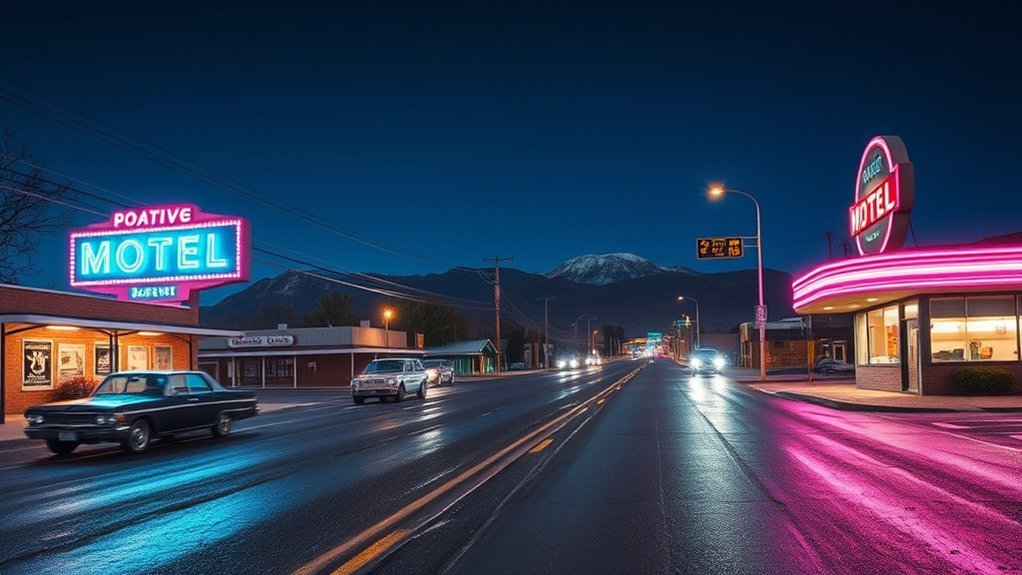
Hop in and roll down the windows—driving Historic Route 66 through Flagstaff feels like stepping into a living postcard where neon signs pulse with mid-century charm. You’ll glide past retro motels, diners glowing in pink and teal, and vintage signage that hums when dusk falls. Let the amber light trace creaky brick facades while you slow for a mural or an old-fashioned soda fountain. Pull over, wander under flickering bulbs, and feel the warm hiss of signage electricity like a heartbeat of the town.
| Stop | What to Look For | Tip |
|---|---|---|
| Weatherford Hotel | Original neon marquee | Take photos at golden hour |
| Historic Downtown | Vintage storefronts | Park and walk the block |
| Sultana Theatre | Restored sign | Check showtimes |
| Route 66 Cruisers | Classic cars on display | Visit weekend nights |
| Diner row | Retro interiors | Try a milkshake |
Drive slowly, savor the textures and colors, and let those neon glows write themselves into your memory.
Hike to the Lava River Cave
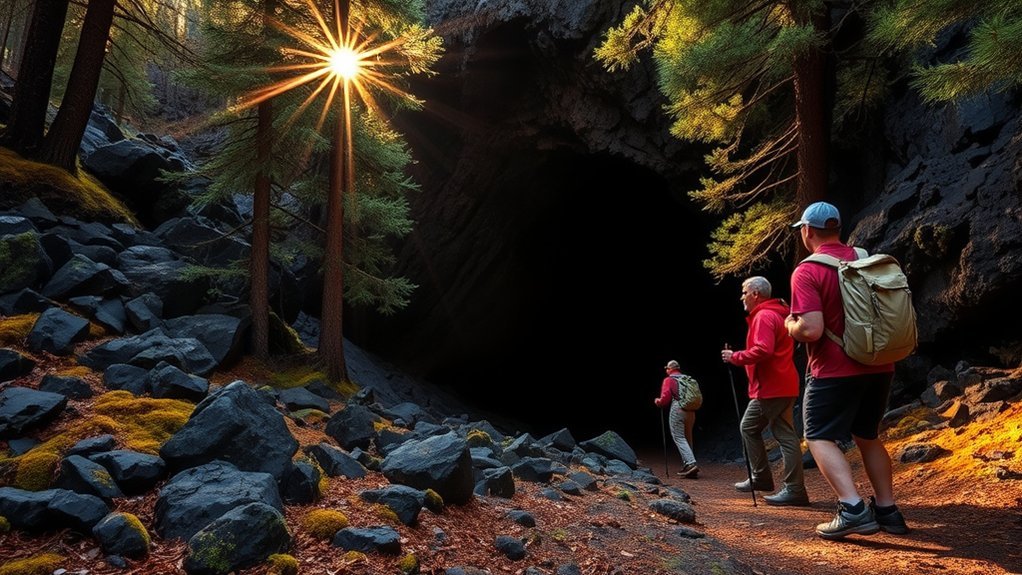
Set out across the ponderosa pines and you’ll feel the air cool as the trail drops toward the mouth of the Lava River Cave, a 700-foot-long tube carved by molten rock thousands of years ago. You duck into near-darkness and your breath fogs; the floor crunches with dusty, black glass and you follow the ribbon of your headlamp. Stalactite-like drip features and smooth pahoehoe walls guide you deeper, and the cave’s steady, cool hush makes each footstep intimate. You’ll sense the ancient force that birthed this tunnel and the tiny, patient ecosystem that clings to its edges. Moving slowly, you notice subtle textures, the faint mineral sheen, and the way sound narrows to your own pulse. Exit to bright forest and let sunlight wash your face—it’s a relief and a reminder of how small and lucky you are to walk this passage.
- Bring a reliable headlamp and spare batteries
- Wear sturdy shoes with good traction
- Carry a light jacket; it stays cold inside
- Respect cave rules; leave formations untouched
- Plan for minimal cell signal and inform someone of plans
Attend a Summer Festival or Concert at Buffalo Park
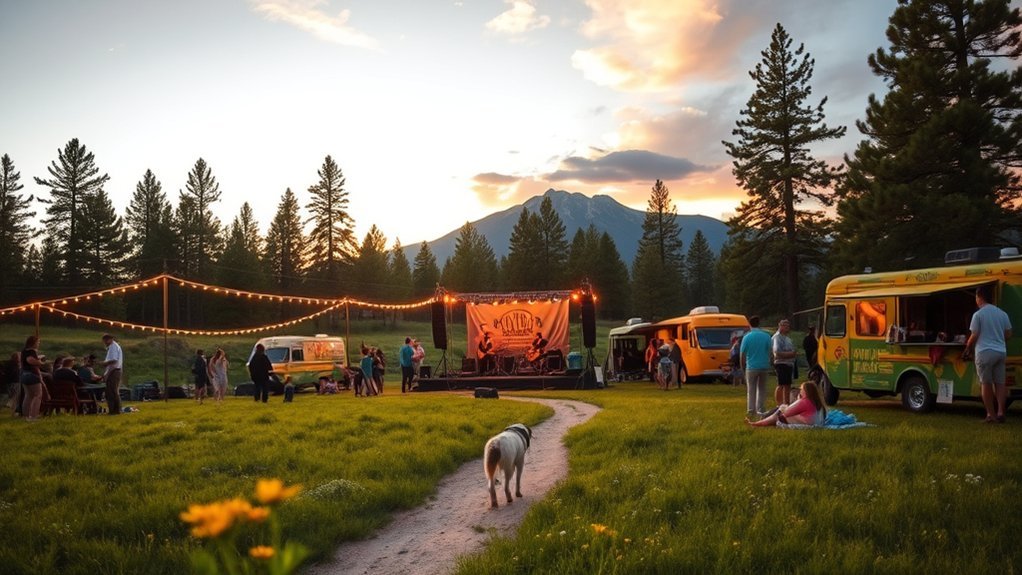
Framed by sweeping views of the San Francisco Peaks, Buffalo Park becomes a sun-drenched stage where music, food trucks, and laughter gather under wide Arizona skies. You’ll spread a blanket on the grassy bowl, feel the cool ponderosa scent, and watch musicians tune as light slants golden across the field. Bands range from folk trios to lively indie acts; rhythms ripple through the crowd and pull you to your feet. Local vendors serve up smoky street tacos, icy lemonades, and sweet fry bread that’s impossible to ignore. Kids chase frisbees while friends trade stories on picnic blankets, and as dusk deepens the stage lights make the peaks glow like a backdrop in a movie. You’ll find impromptu dancing, easy conversations with nearby strangers, and a communal, small-town joy that’s both relaxed and electric. Leave room in your evening for stargazing—the dark sky feels like the festival’s final, quiet encore.
Take a Day Trip to Sedona for Red Rock Views
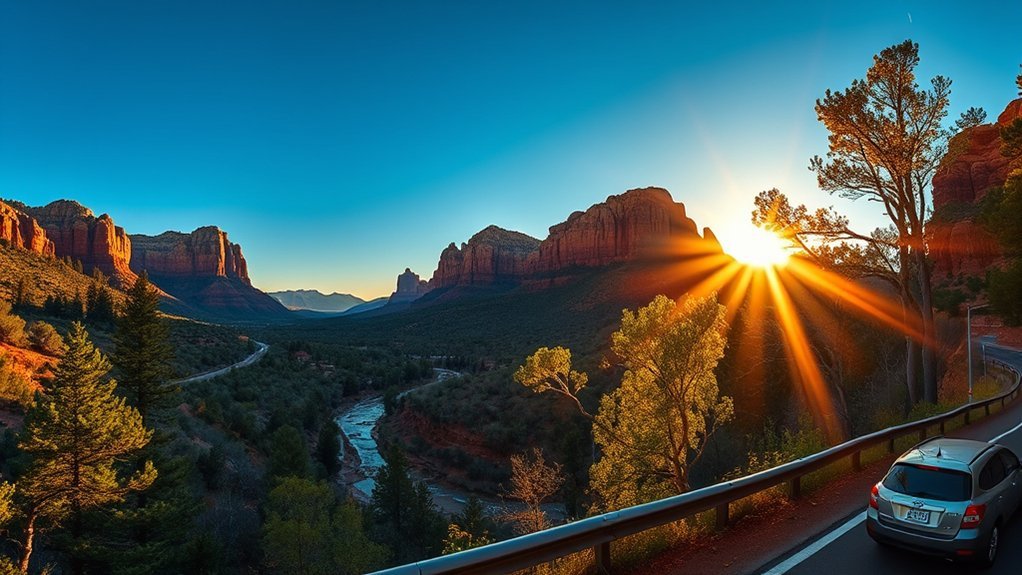
When the concert winds down and you’re craving a different kind of spectacle, a short drive south takes you from Buffalo Park’s pines to Sedona’s unforgettable red-rock amphitheater. You’ll feel the air shift as towering sandstone bluffs glow copper and ochre; pull over at a vista, step out, and let the vista fill your senses. Hike a loop trail to stand beneath spires, watch shadows crawl across canyons, or sip coffee as sun paints ribbed cliffs. Photograph twilight when colors deepen, but also pause without your lens to simply breathe that wide-open light.
- Park at a designated viewpoint for sunrise or sunset
- Pack water, sturdy shoes, and layered clothing
- Choose a short trail like Cathedral Rock or Bell Rock
- Bring a camera with a polarizer for richer skies
- Respect private lands and stay on marked trails
You’ll return to Flagstaff grounded, carrying Sedona’s fierce, calm beauty with you.
Enjoy Wildlife Viewing at Kendrick Park
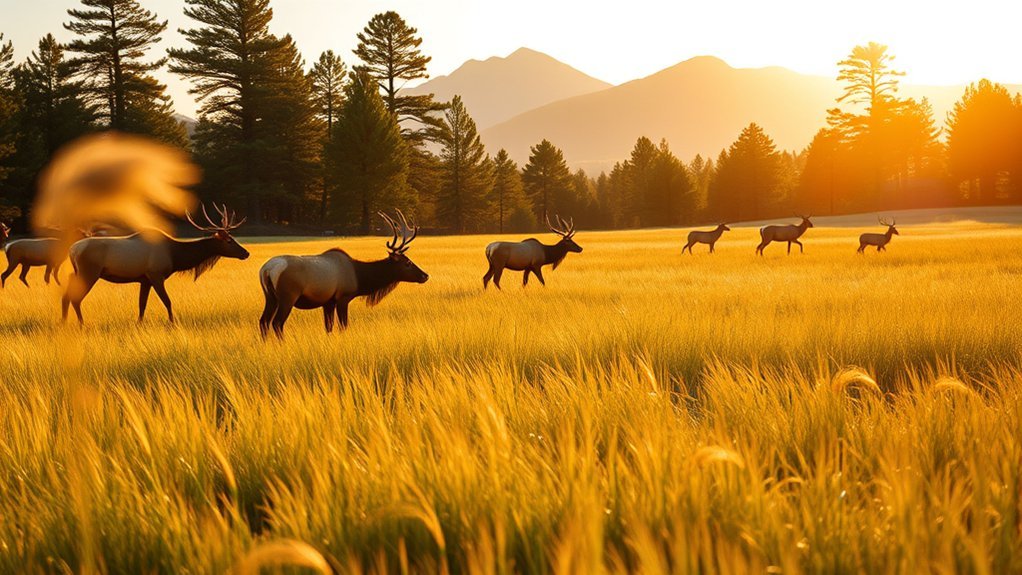
Often you’ll find Kendrick Park‘s meadows and ponderosa edges humming with quiet life, and if you slow down you can watch elk, mule deer, and a surprising variety of birds move through their routines. You’ll wander soft paths shaded by tall trunks, breath fogging in cool air, ears tuned to twig snaps and distant bugle calls. Keep a respectful distance; binoculars bring their world into crisp focus without disturbing grazing herds. Early morning and dusk are richest—light slants golden, silhouettes ripple through mist, and songbirds fill the understory with sudden, intimate melodies. Look for tracks in muddy drainages and listen for the hollow thunk of woodpeckers. Camera gear stays ready but unobtrusive; a quiet shutter captures moments without breaking the spell. Kendrick Park rewards patience: when you stop chasing sightings and simply observe, the landscape reveals subtle rituals—fawns learning to bound, jays harrying ravens, and the slow, deliberate grace of elk moving like living shadows.
Try Rock Climbing or Guided Outdoor Adventures
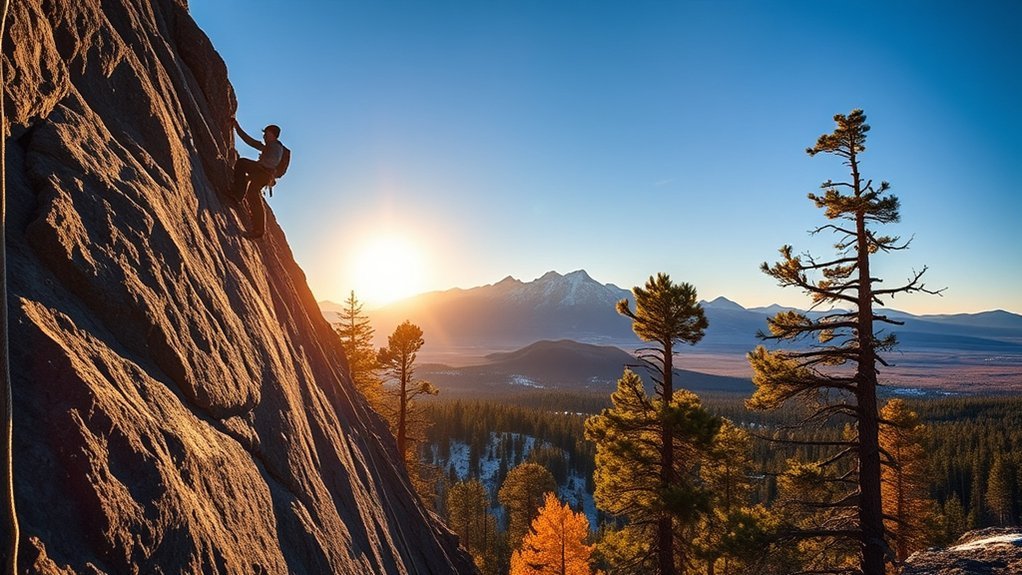
If the forest’s quiet patience has you craving a more physical way to know these mountains, strap on a harness and head for Flagstaff’s cliffs and crags—where guided climbs, via ferratas, and technical routes turn the landscape into a hands-on classroom. You’ll move with intent: fingers finding granite edges, boots searching for footholds, breath syncing to the rhythm of ascent. Local guides tune routes to your experience, point out geology carved over millennia, and teach ropework that keeps you safe while still thrilling. At the top, the plateau opens like a reward—pine-scented air, wide sky, and a view that redraws your idea of distance. Whether you pick a short multi-pitch or a full-day alpine approach, guided outings let you push limits without guessing. After descent, you’ll feel steadier, more present, and quietly proud of terrain you once only admired from below.
- Choose a certified guide familiar with Flagstaff rock
- Check seasonal conditions and sun exposure
- Pack layered clothing and sturdy shoes
- Bring water, snacks, and basic first-aid
- Respect route ratings and your comfort level
Browse the Flagstaff Farmers Market
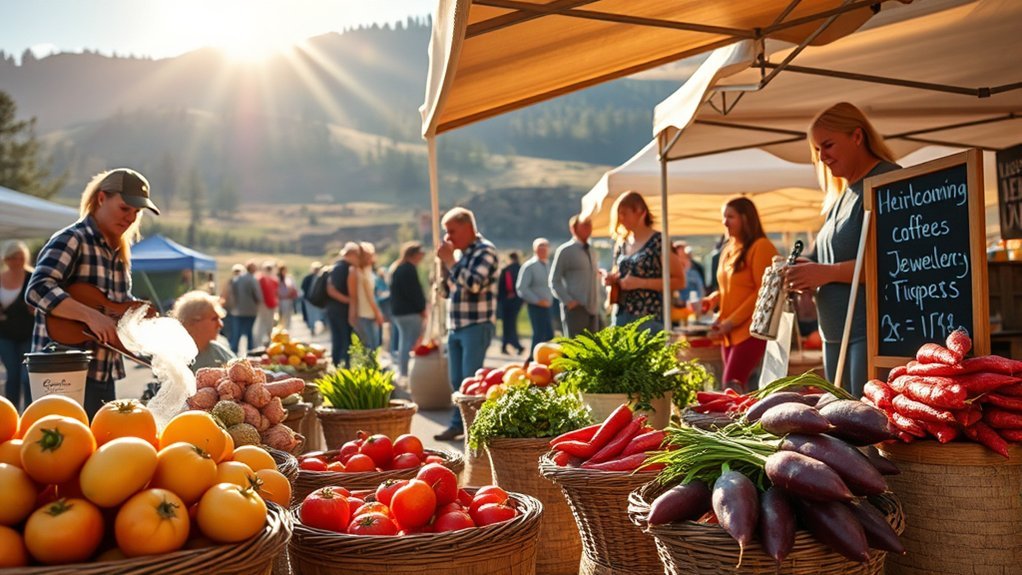
Stroll into the Flagstaff Farmers Market and let the bustle and color pull you from the street into a swirl of local life—vendors call out, aromatic steam rises from food stalls, and stacks of sun-warmed heirloom tomatoes glint like jewels. You wander aisles of folding tables heavy with crisp greens, purple carrots, and jars of honey that catch the light. Farmers answer questions about varieties and growing methods; you taste a sample and feel the difference of soil, altitude, and care. Artisans display pottery, woven baskets, and candles whose scents transport you to ponderosa pines. Musicians play softly nearby, and kids chase bubbles past a mural-painted trailer. You collect a warm pastry, a bunch of basil, and a vial of infused olive oil, each purchase connecting you to the people who made it. Leave with a tote full of seasonality and stories, ready to cook something honest that’ll remind you of Flagstaff the next day.
Relax at a Local Coffeehouse and Bookshop
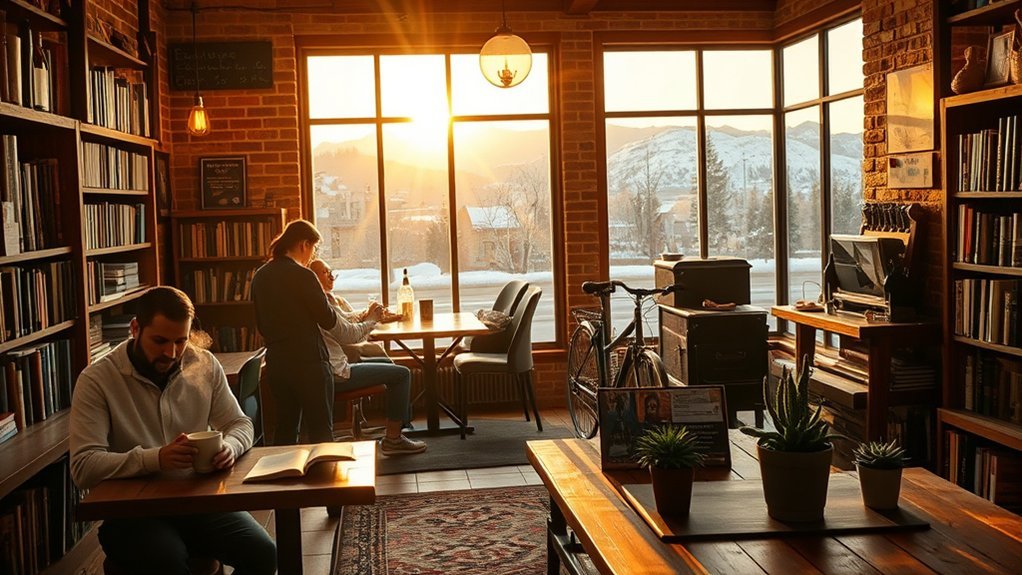
Need a quiet corner? You’ll find cozy nooks in Flagstaff’s coffeehouses where sunlight falls on worn wooden tables and the scent of espresso mixes with old paper. Settle in with a steamy mug, flip through local authors, and let the hum of conversations and clinking cups slow your pace. Window seats frame pine-dusted streets; leather chairs invite lingering. Baristas pull thoughtful shots, recommend a pastry, and sometimes offer a soft playlist that matches the mood. You’ll leave with a dog-eared recommendation, a dog-eared book, or simply a clearer head.
- Choose a window seat to watch Passerine life and drifting snowflakes.
- Order a seasonal brew and a house-made pastry for full sensory comfort.
- Bring a novel or pick one from the shelf to savor the town’s literary vibe.
- Chat with locals or tuck into solitude—both feel welcome here.
- Time your visit for a quiet morning or a mellow late afternoon.
Experience Native American Cultural Sites and Tours
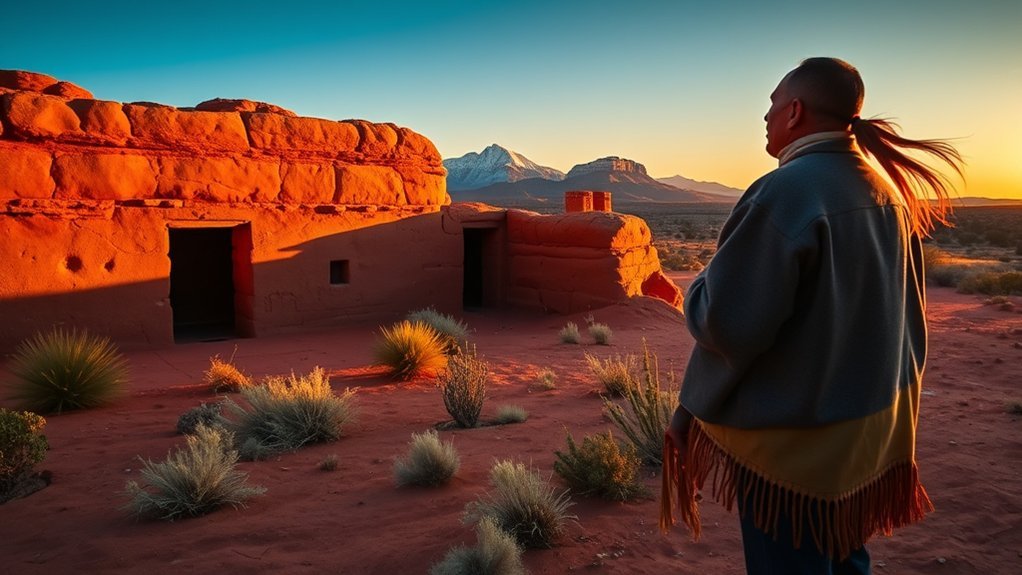
When you step onto ancestral land, voices of the past and present rise in the same breath—storytellers, artisans, and guides invite you to listen, learn, and witness traditions that shape Flagstaff’s soul. You’ll walk pottery-rich pueblos, sacred rock formations, and interpretive trails where elders explain origin stories and seasonal rituals. Take guided tours that pair natural history with tribal perspectives, so the landscape becomes living narrative rather than backdrop. You’ll watch weaving demonstrations, handle hand-fired pottery, and hear languages whose rhythms map generations. Respectful etiquette—asking before photographing, following site rules, and dressing modestly—deepens your connection and honors residency. Seasonal festivals and museum exhibits let you taste ceremonial foods, hear drumbeats, and buy authentic crafts directly from makers. These encounters aren’t tourist curiosities; they’re invitations to witness resilience, creativity, and continuity. Leave with a quieter stride, a fuller understanding, and objects or memories that remind you the Colorado Plateau’s culture endures and speaks still.
Frequently Asked Questions
What Are the Best Family-Friendly Restaurants in Flagstaff?
You’ll love Lumberyard Brewing, MartAnne’s, and Wildflower for kid-friendly menus, cozy patios, and craft sodas; they bustle with warm staff, playful vibes, generous portions, and easy parking, making family meals relaxed, tasty, and memorably fun.
Is Flagstaff Pet-Friendly, and Where Can I Take Dogs?
Yes — Flagstaff’s dog-friendly like a welcoming trailhead; you’ll find leash-friendly downtown patios, wooded Nordic trails, dog parks at Thorpe and Schultz, and pet-friendly hotels, letting you and your pup explore pine-scented streets together.
How Accessible Is Flagstaff for Visitors With Mobility Limitations?
It’s fairly accessible: you’ll find curb ramps, wide downtown sidewalks, accessible restaurants and museums, plus ramps and elevators at major attractions. Some trails and historic sites remain uneven, so plan ahead and bring mobility aids.
Where Are the Nearest Hospitals and Urgent Care Centers?
The nearest hospitals are Flagstaff Medical Center downtown and North Country HealthCare’s urgent care; you’ll also find Banner–University Medical Center in nearby Phoenix for specialties. You’ll reach urgent care quickly from major routes, often within 10–20 minutes.
What Are Parking Options and Fees Downtown?
About 1,200 curbside and garage spaces fill downtown; you’ll find metered street parking, city garages, and a few free lots. You’ll pay $1–$2/hour typically, weekend meters vary, and garages offer day rates.
Conclusion
You’ll leave Flagstaff buzzing with memories: alpine peaks, desert ruins, star-filled skies and craft brews blending into one adventurous pulse. Try a day hike—Humphreys rewards you with 360° panoramas—and don’t miss the Grand Canyon an hour away. Fun fact: Flagstaff gets over 300 clear nights yearly, so bring a jacket and your camera. Wander, taste, climb and pause—this town invites curiosity, slow moments and big, blue-sky wonder.

